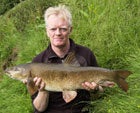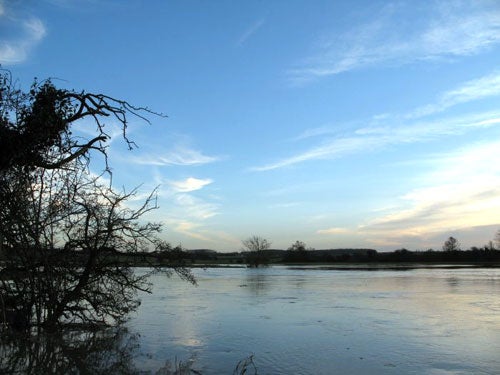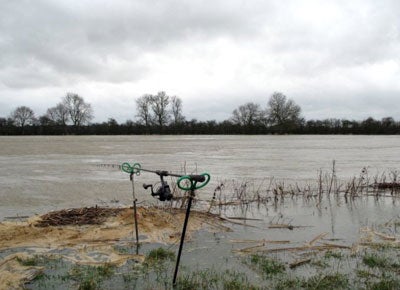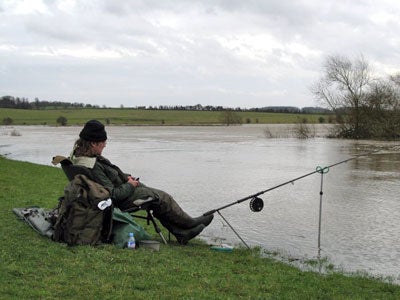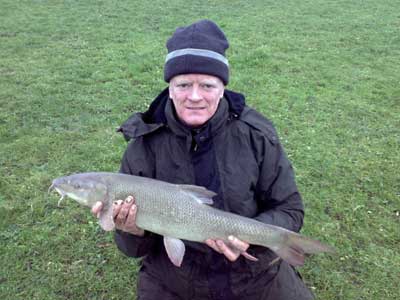| SEAN MEEGHAN | |
Perch, trout, tench and roach are targeted as the fancy takes him. Sean has been a member of the Wharfedale Specimen Group for the last 16 years which has enabled him to learn from some of the finest barbel anglers in the North of England. |
Walking the Walk for BarbelSunday morning 13 January. I’m leaning on the parapet of the bridge at Stoney Stratford with Mick Beecroft, staring glumly at the muddy torrent below. The Ouse was about 6ft up and we’d just taken the water temperature at 5.4 C (spot the digital thermometer!), so we were debating our options. We’d checked out the Ouzel, our usual back-up venue, on the way over and we couldn’t reach it over the flooded meadows. “We could head for home and try the Trent or the Don on the way back.” “Nah, that’s a cop-out. Let’s have a look downstream, none of these southern jessies ‘ll be out so we should be able to find somewhere to fish.” We drove off towards a spot the guy in the tackle shop had suggested yesterday and, 40 minutes later, we were contemplating the raging torrent again. This time we could at least reach the river bank so we set up our rods and went for a wander. We had about 300 yards of river bank before the river spilled over into the fields to form a vast sheet of murky water. At the top of the length was a wide pool where a mill leat entered the river and counting down the lead indicated a depth of about 8ft which dropped off to about 10ft on the crease where the main river channel appeared to be. Further downstream we found an area of steadier water close to the bank with a depth of about 9ft. Mick decided to fish here and I continued a bit further to find a slightly deeper run which, despite the swirls on the surface, allowed me to hold bottom with about 1 1/2 oz of lead. The water temperature here was 5.6 C so either it was on the rise or some warmer water was coming into the river somewhere upstream. Whatever the reason, our confidence rose slightly: there was an outside chance of a barbel.
I left some pellets to soak, set up my rod and attached a medium grip-mesh feeder fitted with a large dead cow. Mick was using a heavy lead with a lumpy pellet paste wrap around his hook bait. I prefer the feeder in cold water as it allows me much greater control over the amount I feed. I drained the pellets and added a generous glug of The Source. With the water temperature so low the aim was to use small quantities of a smelly bait in the feeder with a small pellet on the hook. Both Mick and I have absolute faith in The Source as a barbel attractor after several years of using it in all conditions. I swung my gear out, put the rod in the rests and settled back behind my brolly to shelter from the boisterous wind that was roaring across the river and batting me playfully around the lug holes. Half an hour later a sharp tap on the rod top raised my hopes, but nothing further materialised. After two hours Mick and I gathered to discuss our rather limited options. In fact there were only three: stay put; move to the mill pool; go home. Going home was becoming increasingly attractive, but the water temperature had risen to 6 C so we plumped for a move to the mill pool. As I trudged the 100 yards or so upstream I fretted about the tap I’d had earlier. Was it a fish and, if so, why hadn’t it taken the bait? I thought back to a trip to the river Don before Christmas when I’d switched from pellet on the hook to maggot and turned twitches and pulls into hittable takes. I had some worms in my bag, maybe they’d be a better bet in the conditions. Worms also have the advantage that they attract other fish as well as barbel. So worms it will be then!
It was a different world in the mill pool. The force of the wind was broken by a dense thicket on the far bank and the calmer water added to the sense of tranquillity. Mick had arrived first and set up at the tail of the pool so I dropped in about 10 yards upstream of him. Before starting fishing I cast my empty feeder around the pool to check the bottom contours and find any snags. The bottom was relatively flat and clear of obstructions except for what felt like the remains of a weedbed near the edge of the main channel. I decided to fish on the far side of this, just into the main flow. I impaled a largish dendrobena on the hook, packed the feeder with pellet and cast them the 20 yards or so to my chosen spot. I’d barely had time to settle back into my chair when the rod tip jagged twice. “I’ve had a bite Mick!” “You sure?” He knows I’m excitable and prone to exaggeration. “Yeah. Just going to check my worm.” “Worm?” I hadn’t told him about that bit ….. There was no obvious sign of any damage to the worm, so I refilled my feeder and cast again. This time I had a wait of about 15 minutes before the rod tip nodded once and sprang back sharply. I struck and felt a solid weight followed by a heavy thump. “Got one Mick!” The reply was unprintable. The fish held out in the flow and I began to fret about the weedbed. I stood, held the rod high and began to pump it towards me. Mick wandered up the bank towards me. “Looks like a decent fish.” “Feels like a good chub.” At that point the chub decided it was really a barbel and powered off into the flow. It sulked for a while until the heavy pressure told and I managed to bully it over the weedbed and into the quieter water of the pool. It was 9lb long, but didn’t have any depth and it went 7lb 6oz on the scales. Mick took a quick snap and we returned it to the water. I had a couple of knocks after that, but nothing developed and as dusk drew in we decided on option 3 and headed for home.
The moral of this story is that even though conditions were uncomfortable and the prospects of a fish remote we gave it a go and it paid off. We were alone on the bank as the southern jessies were all at home talking the talk on BFW. Learning points
|










